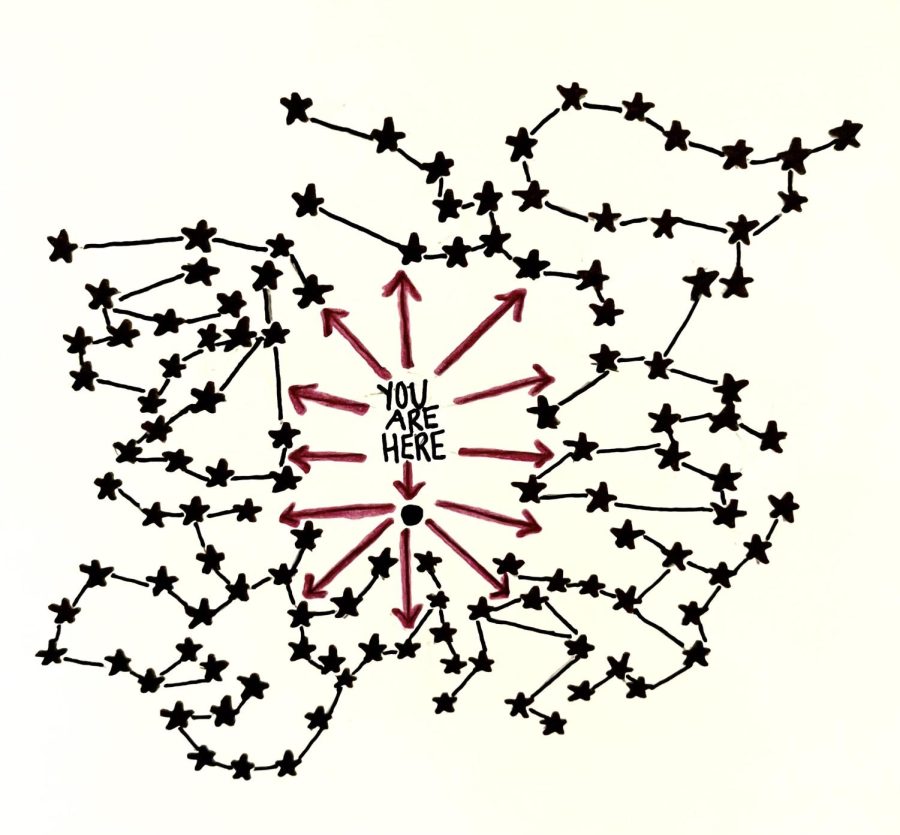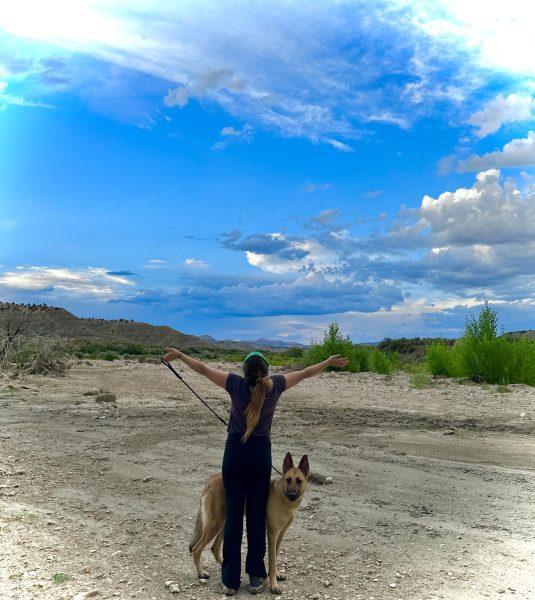Aligning your stars
There are pieces of each zodiac sign that reside within you. Photo and art by Ellie Marty, taken April 27.
Here’s the deal: There are people who walk around taking massive stinky dumps on anyone who believes in astrology and I’ve gathered it’s because they’re misinformed. They’ve learned that astrology is limited to a zodiac sign, that you’re one of twelve options depending on the month and day of your birth and that’s all, goodnight. Wrong — no sleep for you!
Asking an individual their zodiac sign typically results in the same aggravated sigh that I release when someone begins talking to me about the stock market. I’m confused as to what about me signals “Please tell me about liquidity,” and they’re confused as to how someone can be so delusional to take interest in something as bogus as astrology.
I can hear their voices as I write this, “Have you ever thought of investing?” Here’s my answer: I’ll consider listening to stock market mansplainations when I begin witnessing optimism toward astrology, which I hope to increase in any readers who think I sound like an idiot so far.
Defining birth charts
Looping back to one of the greatest, if not the greatest, misconceptions of astrology: we aren’t defined by a singular zodiac sign. There’s an entire birth chart, also known as a natal chart or horoscope you can dive into, which explores dozens of factors that analyze your personality type and even make predictions about your future.
I mean, I get it. If I was a Taurus and someone told me my personality is limited to being a lazy, stubborn, fatso who just stays at home and eats all day — which do happen to be the defining characteristics of Taurus placements for some reason — I’d reject the concept of astrology as a whole and deem it fake as well.
Birth charts map out an individual’s psychological structure in a circle divided into 12 sections based on the signs and houses, planets and their relationship to one another, and the four elements of fire, earth, air and water. They are archetypal mandalas, symbolizing a person’s quest for unity and wholeness. The outline of every chart is the same, but the markings on it are determined upon the date, time and location of your birth.
Birth charts are intimidating to analyze, something you’ll only understand when you see one, but can be read accurately with the right amount of determination. Most websites generating birth charts provide thorough explanations of what exactly your chart implies, so a helpful tip is to scroll down and find that section if you’re feeling discouraged.
Aspects of a birth chart
Your chart features all planets other than Earth, and even a couple asteroids. There are three chart aspects that are considered to be the most prominent in our personalities, the big three: the Sun, the Moon and the rising — or the ascendant.
You were probably told somewhere along the line what your sign is, but it most likely wasn’t ever referred to as a Sun sign and you likely weren’t told what its significance is. As an example, when someone asks for my sign I say, “Gemini.” What I’m actually saying here is that the Sun was in the sign of Gemini on the date of my birth.
Your Sun sign represents your ego, how you view yourself and nothing else. This is only a bite-sized portion of the zodiac pie you’re baked in and could explain why you heavily resonate with it, but loved ones don’t see any resemblance between you and how your Sun sign is depicted. It could also explain why you may not resonate with it at all, but we’ll get to that later.
Your Moon sign symbolizes how you emote. Depending on its placement it could symbolize your maternal or paternal relationships, how you cope with your feelings, as well as how you maneuver them.
The ascendant or rising sign is the sign that was on the horizon, or rising, at the moment of your birth. It’s typically known as the mask you present to others upon first impressions and is also linked to how you perceive your surroundings.
A step further from the big three is the big six which includes the Sun sign, Moon sign, rising sign, and additionally the Mercury, Venus and Mars placements. Your Mercury sign reveals how you communicate, your Venus sign reveals your relationship to love and what you find lavish, and your Mars placement indicates energy, action, aggression and sex.
Remainder placements include Pluto, Saturn, Jupiter, Uranus and Neptune. There are also Node, Lilith and Chiron placements, as well as 12 houses, each associated with a specific sign and planetary ruler that represent different areas of life — the houses are where the freaky accuracies really come into play.
Chart rulers
If you read through all of these placements in your chart and they still didn’t rip you apart to your liking, or perhaps your chart doesn’t quite resonate with you, take a look at your chart ruler. But don’t take it out on me when it makes so much sense that it hurts your feelings.
Your chart ruler determines the central theme of your cosmic footprint and it is completely singular and unique to you. In order to identify it, you’ll need to take a look at your rising sign and the planet it’s ruled by, then find out the house in which that planet resides and the sign it occupies.
For example, my rising sign is Scorpio, which is ruled by Mars and it falls under the first house in the sign of Aquarius. According to my chart, my mars chart ruler in Aquarius could mean that I am often seen as someone who will do things my own way, regardless of consequences. There’s no other choice for me but to be true to myself.
My placement in the first house suggests that some personal issues are a major focus of my life and learning to embrace myself is a focal point in my journey. It suggests that I count on myself as opposed to others, maintain authenticity and find importance in the impressions I make on others — it just gets more embarrassing.
The precision of astrology
Another misconception about astrology is that there’s no logic to it. It’s not a science or a religion, so many deem it random. But like the stock market penis that so many currently deepthroat, astrology is also based on precise numbers and math — surprise!
Astrology utilizes a 360-degree circular chart which served as a guide for the ancients when it came to placing the four cardinal signs of the zodiac. It is equally divided according to two equinoxes, which are astronomical points where the sun’s path crosses the celestial equator, and two solstices, which are astronomical points marking when the sun is at its highest and lowest points on its path in relation to the celestial equator, and is entirely based on our 365 day year.
The lengthy history of astrology
By the way, when I say “ancients,” I mean ANCIENTS. The Sumerians were the first Western culture to acknowledge the movement of the stars in Mesopotamia as early as 6000 B.C. Babylonian astronomers recorded the first astrological tables in 2400 B.C. and over thousands of years, based on observations of their planetary cycles and their relevance to significant events occurring in their civilization, they would come to conceive the first born of astrology systems, which would be considered synonymous with astronomy until the 1800s.
Greeks would come to adopt Babylonian astrology around 331 B.C. as they took leaps in mathematics, medicine, geometry and philosophy that advanced and enhanced the practical applications of astrology as a science. They also acknowledged it as a core of the seven fundamental sciences due to astrology’s incorporation of all the key elements of its other six science siblings.
Credit is due to Greek literature when it comes to the names and significance of the planets and zodiac signs we’re familiar with today. Claudius Ptolemaeus, commonly referred to as Ptolemy, was an encyclopedist who created and published a comprehensive record of philosophies and techniques used at the time of his life in A.D. 140 called the “Tetrabiblos.” In this work Ptolemy presented an astrological system that employs planets, signs, houses and aspects, all which reside at the core of how we currently view astrology.
Western astrology eventually fell into the laps of Arabs, which happened because there was open trade between Eastern and Western cultures consisting of swapping astrological knowledge. Arabs quickly preserved Western astrology’s attributes and incorporated it into their own astrological systems. Astrology had become a fundamental aspect of Western education with Ptolemy’s work listed as required reading for any and all scholars.
Astrology continued to develop and evolve throughout the Middle Ages up until the final years of the Renaissance with advances in mathematics and measurement, encouraging precision. Astrologers were enabled to generate their most accurately timed charts yet, pushing their practice to be acknowledged as a foundational aspect of the culture of the times as it was practiced by healers, physicians and court-retained royal astrologers — I didn’t know they existed either.
Any semi-educated person during this time had strong foundations in astrological knowledge. Astrology also became available to common people around this time as in previous years, only royalty were deemed important enough to have their charts calculated and analyzed.
In the mid-1600s William Lilly, a highly accomplished and important astrologer in his time, published his astrological legacy called Christian Astrology, one of the most detailed textbooks on horary astrology ever published which included some weirdly accurate predictions. For one, Lilly predicted the Great Fire of London 15 years prior to the flames. He was instigated as a possible contributor to the fire, but was later acquitted.
As the power and influence of the Church grew, the practice of Western astrology appeared to shrink. Astrologers who were once esteemed members of society were drastically reduced to the rank of parlor magicians and fortune tellers. The Academy of Sciences in France banished astrology in 1666. Overall, astrologers were no longer recognized or respected as members of the mainstream club.
Astrology began to scratch the surface of popularity yet again and became an open practice in the 1890’s with interests peaking in spirituality and mysticism. Carl Jung is a notable European from the time who incorporated a lot of astrological symbols in his psychological work.
Also around this time, astrologer Alan Leo strived to shift the focus of his approach to astrology from fortune telling to psychology. England had strict laws that restricted fortune telling at the time and Leo’s objective ultimately landed him in jail, an event which conveniently marks the beginning of natal astrology as we’ve come to understand it today.
The American astrological community gained traction around the late 1960s and 1970s as new techniques continued to be proposed and put up to the test. A trend rose during these years showing the desire to move away from negative interpretations that had previously been utilized in classical astrology. Instead, people began to search for and discover more empowering ways to analyze birth charts. This was also when the Sun sign horoscope columns, which originally debuted in England in the 1920s, began to grow in popularity.
Present day astrology
Before you could finish saying all 12 zodiac signs, astrology was embraced by pop culture once again, or at least kind of. The daily horoscopes you can find in magazines or on your Snapchat discover page are a diluted and disoriented version of astrology. For some, this is all they know of astrology, furthermore making it understandable as to why so many people reject the concept of it.
Despite the haters, astrologers have persisted in their practice and study as modern technology continues to enable them to combat the hardships their ancestors became routined to. Nowhere near as much time or precision needs to be invested into calculating birth charts today, so present day astrologers have the opportunity to be experimental with the wide range of classical techniques available and rediscover the roots of astrology.
With all this being said, let me know if I need to start investing in stocks.
To take a look at your birth chart and all the aspects it entails, click here.
Ellie Marty can be reached at [email protected].

















